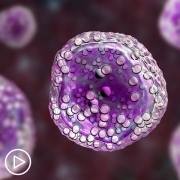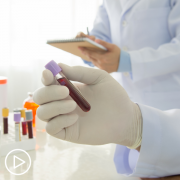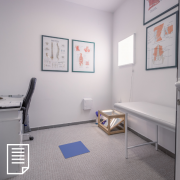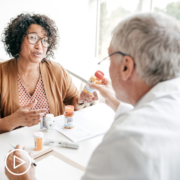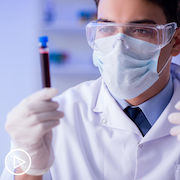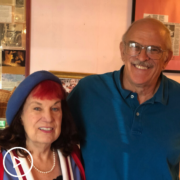DLBCL Treatment Decisions: What’s Right for You? from Patient Empowerment Network on Vimeo.
When considering therapy for diffuse large b-cell lymphoma (DLBCL), what determines the best treatment for YOU? Lymphoma expert Dr. Loretta Nastoupil shares key decision-making factors, emerging research, and tools for partnering with your healthcare team.
Dr. Loretta Nastoupil is the Director of the Lymphoma Outcomes Database and Section Chief of New Drug Development in the Department of Lymphoma/Myeloma, Division of Cancer Medicine at The University of Texas MD Anderson Cancer Center. Learn more about Dr. Nastoupil here.
Download Program Guide
See More From The Pro-Active DLBCL Patient Toolkit
Related Programs:
Transcript:
Katherine:
All right. Hello and welcome. I’m Katherine Banwell, your host for today’s program. Today, we’re going to discuss how you can be proactive in your DLBCL care and work with your healthcare team to find the best treatment path for you.
Before we meet our guest, let’s review a few important details. The reminder email you received about this program contains a link to program materials. If you haven’t already, click that link to access information to follow along during this webinar.
At the end of this program, you’ll receive a link to a program survey. Please take a moment to provide feedback about your experience today in order to help us plan future webinars.
Finally, before we get into the discussion, please remember that this program is not a substitute for seeking medical advice. Please, refer to your healthcare team about what might be best for you.
All right. Let’s find out who we’re talking to today. Joining me is Dr. Loretta Nastoupil. Thank you so much for coming on the show with us. Would you please introduce yourself?
Dr. Nastoupil:
Sure. Thanks, Katherine. I’m Loretta Nastoupil. I’m in the Department of Lymphoma and Myeloma at the University of Texas MD Anderson Cancer Center. I’ve been here since 2013, and I currently lead our new drug development team in our lymphoma section.
Katherine:
Thank you so much for taking time out of your busy schedule to join us. So, let’s start with a basic question, what is diffuse large B-cell lymphoma or DLBCL?
Dr. Nastoupil:
That’s a really important question. And I spend a lot of time when I first meet patients explaining to them there are a lot of different terms that are thrown around in lymphoma. Particularly, non-Hodgkin lymphoma is a term many patients will hear and even use. And I remind them that that is sort of an umbrella term that describes essentially every lymphoma that’s not Hodgkin lymphoma.
So, it’s really important to recognize that there are unique types of large cell lymphoma. And almost everything that we care about in terms of what the treatment will look like, whether or not we’re aiming to cure someone, or just maintain adequate disease control is primarily focused on the type of lymphoma someone has.
So, diffuse large B-cell lymphoma is the most common lymphoma subtype. Just in terms of its descriptive name, it is a B-cell cancer. And it is comprised of large cells that are essentially effacing or replacing the architecture of a lymph node.
There are different types, which I’m sure we’ll discuss. But, again, diffuse large B-cell lymphoma is our most frequent lymphoma we encounter.
Katherine:
What is B cell? What does that mean?
Dr. Nastoupil:
Sure. So, stepping back a little bit, I think most people when they know or have known someone with cancer, it is described as the organ it originates in. So, breast cancer’s a great example. That usually is breast tissue that is abnormal. It has malignant potential. And if it spreads beyond its capsule and specifically goes to a lymph node or another organ, generally that’s bad news.
Lymphoma is a cancer of the immune system. And there are various types of immune cells. B cells – they mature on and become plasma cells when they’re behaving normally. And their job is to generate antibodies so that we can develop immunity from exposures or infections we’ve had and we’ve recovered from.
So, if you develop a cancer in the B cell, depending what stage of development – if it’s a stem cell, for instance, that can lead to acute leukemia. If it’s an immature B cell, meaning it has not developed into a plasma cell, that’s, generally, where diffuse large B-cell lymphoma arises. So, these cells tend to live or spend most of their time in lymph nodes because they’re trying to mimic the behavior of a normal B cell where they’re waiting there for that exposure to happen.
So, these are generally not cancers that we try to cut out before they spread. They’re not spreading cancers in terms of how we generally think of those, meaning you’re not going to use surgery to treat it. And, oftentimes, there are malignant B cells kind of dispersed throughout the body because if you think about how your immune system should work, it should be able to fight off an infection anywhere and everywhere.
So, I think those are key things to keep in mind because oftentimes patients will have widespread involvement or lymph node involvement or bone involvement, and that’s just the nature of the disease and not necessarily something that is so far progressed we didn’t catch it early enough.
Katherine:
I see. Are there subtypes of DLBCL?
Dr. Nastoupil:
Yes, absolutely. So, again, stepping back, over the last 20 years, we have tried to understand why we’re able to cure about 60 percent of patients. But for the 40 percent that were not cured with standard treatment, their outcomes were generally poor, meaning most of those patients died as a result of their lymphoma.
And we’ve approached all of them the same. So, that would imply to us that there’s something inherently different about the large cell lymphoma cases that don’t respond to standard treatment. So, an attempt to try and define who those patients are before we initiate treatment, as technology has evolved, we’ve interrogated some of those biopsy samples to try and understand is there an underlying biologic rationale as to why some patients would have very, very disparate outcomes?
So, what we’ve learned is there are genes that are differentiated between different subtypes of large cell lymphoma. And we’ve described those subtypes based off those gene expression patterns. So, there is a germinal center type of large cell lymphoma. There’s a non-germinal center or activated B-cell type.
And then it gets much more complicated meaning there’s probably far more than just two subtypes. Right now, we’re describing at least five different subtypes. I think what’s important for patients to know is that we view this in terms of being able to predict who’s not going to have the typical course. And if we can define who they are, we might pursue something different, including potentially a clinical trial.
So, the subtypes I care the most about right now in terms of defining are the double hit or double expressors, those with other features that might lend itself to targeted therapy.
So, this is an evolving field and will continue I’m sure – that will have more subtypes defined over time.
Katherine:
Let’s look into testing for a moment. What tests are essential when making a diagnosis?
Dr. Nastoupil:
So, at the beginning, we clearly have to have tissue. I always say, “Tissue is the issue.” So, we may have features that are suggestive of lymphoma. And even sometimes radiologists will describe a CT scan or an x-ray and say, “This looks very suspicious for lymphoma.” But unless we actually have a biopsy that confirms lymphoma, we won’t go as far as to render a diagnosis in the absence of a biopsy.
Now our biopsy approaches have evolved over the last few years. The gold standard or what I would consider to be the best approach currently is to actually have an incisional biopsy meaning we find a lymph node that looks suspicious.
And we either remove the entire lymph node or a large section of that lymph node to render a diagnosis because there’s various things we need to do to that lymph node.
So, generally, we do what’s called immunohistochemistry staining. So, we stain either surface markers of those cells or markers within the cell because cancer is defined as having an abnormal clone or a population of cells that all have the same features. And they’re able to survive even if the host is not thriving.
So, that’s, essentially, what we’re trying to define. Are there cells in this lymph node that are all the same? And what features do they share in common? And then we will also do something called flow cytometry where we’ll take these cells and essentially sort them according to those surface markers. And that will also tell us – is this a B-cell clone, a T-cell clone, and what features would distinguish one lymphoma from another?
And the last thing that we need tissue for are what we call molecular studies, where we may learn about either genes that are rearranged or mutated within those cells that, again, may help us further classify the lymphoma and, again, group them into higher or potentially lower risk groups.
Katherine:
What do the results of these tests tell us about prognosis and treatment choices?
Dr. Nastoupil:
So, again, everything kind of hinges on what type of lymphoma we’re facing. So, for instance, diffuse large B-cell lymphoma is what we call an aggressive lymphoma. So, what does that mean? It can grow very quickly. It can take over the patient in terms of resources. So, generally, patients will have weight loss and sometimes even constitutional symptoms or B symptoms, such as night sweats and fevers, fatigue.
In the absence of treatment, it is universally fatal. Now, that timeline can vary from one person to another. But, generally, within a year, if we don’t treat large cell lymphoma, generally, that’s not survivable.
But as I’ve also mentioned for at least 60 percent of patients and potentially even more, we can cure it with standard treatment. There are other types of lymphoma, such as indolent B-cell lymphomas where actually the goal is not cure, but patients may actually have a normal life expectancy meaning they will face multiple treatment courses over their lifetime. But at the end of the day, they should live just as long as someone their same age and sex who doesn’t have lymphoma.
So, again, that’s gonna be a vastly different treatment course and outcome. So, sometimes, when you’re sitting in the waiting room and you’re sharing your journey with others, you have to keep in mind that you may all be using the same term, non-Hodgkin lymphoma. But our expectations in terms of to and outcomes might be vastly different.
Katherine:
From person to person. What are the stages of DLBCL?
Dr. Nastoupil:
So, we currently use what’s called the Ann Arbor staging system. And, again, this is very different from the staging applied in solid tumors.
And so, the way we define stage is based off where the tumor is in relationship to the diaphragm. So, if you have the disease just in lymph nodes and it’s all confined to one side of the diaphragm, it’s either gonna be stage one or two. And how we distinguish between one or two is just really not are they in close proximity and something that we would fit in one radiation field.
If you have disease that’s above and below the diaphragm, that’s generally at least Stage 3. Stage 4 is generally when it’s now outside of the lymph node. So, what we call extranodal location. So, those are generally organs, lung, liver, skin, bone, etcetera.
It can be very complicated in that you could have just one extranodal site. So, say you just have stomach involvement, or you just have one area of the bone. That could be a 1E.
So, it’s important to recognize every patient has a stage. What that means is whether or not we would give a full course of therapy in terms of systemic treatment that goes through the vein or maybe a shortened course in radiation is dependent on that stage.
Katherine:
Now that we understand a bit more about DLBCL and how it’s staged, let’s move on to treatment options. Many factors come in to play when making a treatment decision, including a patient’s age and overall health. So, let’s walk through some of these considerations. Let’s start with treatment goals. What does this mean exactly? And what are the goals of treatment for DLBCL?
Dr. Nastoupil:
Great questions. For diffuse large B-cell lymphoma, my goal was that I want to eradicate this disease with one course of therapy. Now one course of therapy, again, may mean six cycles of treatment, or it may mean three to four plus/minus radiation. And that kind of gets back to the discussion we just had with stage. But the goal is to make it go away and never come back. Now, oncologists are eternal optimists.
And I saw this because we would not be oncologists if we weren’t always focused and hoping for the best outcomes for our patients.
Katherine:
Sure.
Dr. Nastoupil:
So, we, generally, when we’re counseling patients tend to keep the focus on what is the chance that I can cure this, and we use words like cure oftentimes. But there’s always those caveats. And those caveats are – we can’t really look into our crystal ball and predict the future for every given patient. So, we use tools to help us risk stratify patients, meaning if we took 100 people like a given person, we could predict the outcome for the majority of those patients.
So, with diffuse large B-cell lymphoma with no high-risk features – so, that gets back to the molecular subtype. Do they have double hit features – yes or no? The stage and something we call IPI, International Prognostic Index, that takes into account some clinical features. As you mentioned, patient specific factors, their age, their stage, some lab values, whether or not they have more than one extranodal variable. Then we can generally predict.
Again, if I have 100 patients with good risk IPI, 80 percent of them are likely to be cured and alive and well five to 10 years later. If I have someone with poor risk features that may not change exactly what I do for that patient, but that may help them and me in terms of should I be pursuing a trial to potentially have access to something that’s better than this standard option? Or how does this impact their planning?
Some people are close to retirement. Some people have specific life goals, such as a wedding or an anniversary that sometimes we use those sorts of calculators to best predict the future to inform some of that treatment. So, those are what we call sort of the characteristics coming into treatment.
There are comorbidities or sort of concomitant medical problems, such as heart disease, sometimes diabetes. But, generally, more often than not, it’s how healthy your heart is because my objective with treatment is to cure this.
Cure generally results from chemotherapy. And we can spend some time talking about why have we not moved away from chemotherapy in this disease? But, generally, that does involve chemo because that’s generally how I can eradicate this tumor.
But there are certain situations where that chemo may not be beneficial to a given a patient. It usually has to do with how healthy their heart function is at baseline. So, again, we look at all of these factors. What is their risk with the disease? What is their risk from the toxicity of treatment? And am I able to achieve that goal, which is to eradicate the disease?
Katherine: Well, let’s talk about chemotherapy. Why is that still part of the regimen in a treatment plan?
Dr. Nastoupil:
Yes, I’m gonna borrow an analogy that one of my colleagues Jason Westin uses all the time. The CHOP chemotherapy that is the backbone of our treatment for diffuse large B-cell lymphoma was developed in 1976.
There is no other technology that we would commonly use in our day to day. You wouldn’t still be driving your car you had in 1976. Clearly, our methods of communication in regards to phones have changed dramatically. So, why are we still using chemotherapy that was developed in 1976?
Katherine:
True.
Dr. Nastoupil:
Well, it’s not for lack of trying. Over the last four or five decades, we have been trying to improve upon this. And it works. It works for at least 60 percent of patients. When we tack on targeted therapy, such as immune therapy where we use an antibody that will stick to the surface of a marker on that lymphoma cell and then use the immune system to do some of the heavy lifting, we can probably improve those cure rates from 60 percent to potentially as high as 80 percent. That’s really been the only substantial improvement we’ve made.
Now, there is one caveat. So, just recently, we heard a press release of the POLARIX study, which is the first trial in the last four decades that could potentially replace R-CHOP as the standard of care.
We don’t have the full results yet. It’s essentially utilizing a drug called polatuzumab, which is an antibody drug conjugate. It’s essentially chemo on a stick. But we’re delivering chemo specifically to (CD)79b, which is a target on B cell lymphomas and modifying the CHOPs. We’re not getting rid of chemo altogether. We’re dropping one of the chemotherapy agents and replacing it with this targeted agent. So, it’s essentially CHP plus rituximab and polatuzumab might be the new standard.
But, again, that’s based off many, many efforts to try and replace CHOP. And we’re making slow incremental improvements, but we’re still keeping the therapies that tend to work.
Katherine:
And that makes sense. What about biomarker testing results?
Dr. Nastoupil:
So, in a perfect world, we would be able to take a patient’s specific tumor, sequence it, and provide a recipe or a solution to solve the problem. And that’s what a biomarker is.
It’s something that’s unique to the patient’s given tumor that then would inform what is the best treatment. So, we’re lacking in some ways a perfect scenario. What we do have, as what I’ve mentioned, some molecular studies where we can look for specific genes or rearrangements in the genes that may help us predict the future.
And in diffuse large B-cell lymphoma, one of the most common examples of this is what we call double hit where we’re looking for two genes – MYC, which is M-Y-C, and either BCL2 or BCL6. These are genes that we all have. It’s just the lymphoma has moved these genes into sort of more of a prime real estate location that makes it a little bit more resistant to standard treatments.
So, if you move those genes in that tumor DNA, we call that our rearrangement. And we pick that up based off a FISH study. And if both of those features or all three of those features are there, we call it a double or triple hit.
That’s a potential biomarker that may suggest that particularly R-CHOP or standard treatment may not be the best strategy. There’s some limitations to that conclusion in that that’s not true for every patient. For about 20 percent to 30 percent of patients with double hit features, they’re gonna do really well with R-CHOP.
So, that’s why we are lacking in how effective these biomarkers are. And it would be great if we had additional biomarkers that were more precise or could tell us more than just that the standard may not be optimal.
So, that’s where we’re spending a great deal of time and effort in our research efforts just trying to identify biomarkers that may tell us what’s the best approach for a given patient or what we like to call personalized medicine.
Katherine:
Exactly. Does treatment typically start right away?
Dr. Nastoupil:
Hopefully. So, what I mean by that is everyone has to have a diagnosis. And a common story that I hear is that patients generally know when they’re not doing well. They may not be able to pinpoint I have lymphoma.
But they usually will see a primary care doctor or depending on the location of a lymph node if it’s palpable. Oftentimes, men when they’re shaving will pick up a lymph node in the neck. Or women if they’re having a mammogram will pick up a lymph node in the axillae or under the arm. So, that may lead to further investigation based off the location of a lymph node.
Or it may just be those constitutional symptoms where people aren’t feeling well, and a primary care doctor is their first stop. Lymphoma is rare. So, usually it’s a diagnosis of exclusion or something that we eventually get around to. That is important, but it’s not that important.
So, what I mean by that is I hope patients don’t have any guilt or regret if they’ve been sitting on symptoms for a while or even if their primary care doctor missed signs and symptoms of lymphoma because, again, it’s not very specific. There are a lot of things that can cause similar presentations.
But once we have imaging that is suggestive of lymphoma and then we have a diagnosis that’s rendered, again, followed by a biopsy, generally, then it is important that they seek care.
And they get that care in a timely fashion. What’s kind of interesting is the longer time from diagnosis to the initiation of treatment in diffuse large B-cell lymphoma is usually associated with a better prognosis. So, that’s sort of counterintuitive.
One would think that the sooner you get started on treatment, the better your outcome will be. I think the challenge with interpreting that data is that the longer time from diagnosis to initiation of treatment usually means that that patient’s disease is one that lends itself to the affordability of time to be seen by specialists, have all of your staging studies completed, have a return visit to go over all those results and have a shared decision-making process in terms of deciding what’s the best treatment for you, and then getting started on that treatment.
So, those patients where that is agreeable and acceptable, they’re probably gonna do very well.
For the patients who are really sick and they need to get started on treatment sooner rather later as a result of their disease putting them at risk, either as a result of organs not functioning well or substantial symptom burden as a result of their disease, then they need to get started. So, that’s usually why their course from diagnosis to treatment is generally shorter.
So, again, it all kind of depends on a given situation. But with diffuse large B-cell lymphoma, I tell patients usually within three months of knowing you have lymphoma, we need to get you on treatment, or you’re gonna be sick.
Katherine:
I can imagine. You touched on this a few moments ago. But what do you feel is the patient’s role in this whole decision?
Dr. Nastoupil:
So, I’ve actually been a patient myself, and I have mixed feelings about it. I think oftentimes as an oncologist, we share decision-making when we don’t know the exact path forward, meaning if there’s something controversial or you have more than one option, generally, we kind of put out all the information to the patient, and we want you to be part of that decision-making.
And I think that’s important because we’re all humans, and we all want liberties. And we want our patient rights to be acknowledged and respected. And that’s important. I think sometimes though that also burdens patients with making decisions when they may feel they don’t have all of the information to make an informed decision.
But your role as the patient is you know your body better than anyone. And, generally, if there’s something that just doesn’t fit well or sit well with you, be vocal about it. So, I’ve been in a situation where I felt like I had to speak up a few times, and not that I have all the answers. And I am an oncologist. So, I generally have more insight than others.
But, generally, I was right in that, again, I think we know our own bodies. And when you feel that something is being missed or maybe not given the time and attention it deserves, speak up. You also have a role in making sure that the diagnosis is correct.
So, I generally advise all patients because everything hinges on the diagnosis in lymphoma, more so than the staging, more so than sometimes even the treatment itself.
Getting a second opinion can be incredibly valuable because you have another pathologist that will lay eyes on this biopsy. And lymphoma is rare. So, a second opinion can be incredibly valuable, and that’s usually something driven by a patient more so than an oncologist. Though some oncologists – and I would say the majority – are open to an opinion because they too would like information or confirmation that they’re on the right path.
Katherine:
Certainly.
Dr. Nastoupil:
The other thing that I think patients can have role is exploring what trial options are out there and available to them. I think that is sometimes a tough subject to discuss. Clinical trials are not only for patients who have failed all the standard treatments.
And it’s usually not an option of hospice versus a clinical trial. That’s absolutely an inappropriate time to consider a clinical trial. And, generally, there are trials at any point in a patient’s journey where there is some controversy as to the best path forward.
Again, I’ve been discussing the last 40 years of trying to improve upon R-CHOP is because 60 percent of patients were cured, but 40 percent were not. There is always a scenario where we could do better. And, generally, the only way we will improve upon outcomes is to conduct important rational clinical trials.
So, sometimes, it’s as simple as reaching out, participating in programs such as this, reaching out to the Lymphoma & Leukemia society or the Lymphoma Research Foundation to just explore what are your trial options. They may not be appropriate for you right now but at least understanding where there is an opportunity to participate in a trial is worth exploring.
Dr. Nastoupil:
Dr. Nastoupil, now that we’ve discussed factors that go into the treatment choices, can you walk us through the currently available DLBCL treatment approaches and who they might be right for?
Dr. Nastoupil:
Absolutely. So, again, this is changing, and that’s good news. So, up until recently, R-CHOP or rituximab in combination with CHOP, which is an acronym for four different drugs, cyclophosphamide, doxorubicin, vincristine, and prednisone, has been our standard.
Again, what would potentially challenge that is the POLARIX study where we exchange vincristine for polatuzumab. We don’t know the results of that study yet. All we know is that it met its primary endpoint, meaning it met what it set out to do in terms of improving upon some of the outcomes achieved with R-CHOP.
We need to see the details to know if that means now every newly diagnosed diffuse large B-cell lymphoma patient will be offered the polatuzumab in combination with R-CHP study or whether or not there will still be some patients appropriate for R-CHOP.
But that is generally our first approach. Whether you get six cycles or a shortened course plus/minus radiation depends on your state. Once patients have completed therapy, generally, then we pursue what’s called surveillance.
So, we’re monitoring for any signs that the lymphoma has recurred or has not gone away. That’s a controversial topic in terms of how to conduct surveillance and one that I suspect will change over time. But for most patients, if the lymphoma is going to recur, it generally recurs within the first two years.
So, assessing patients either in the form of a CT scan, a PET CT, or a physical exam with labs every four to six months for the first two years is what most practices will pursue. I’m not saying that there is no chance that you would relapse beyond two years. It’s just that the majority of patients, at least 90 percent, if the lymphoma comes back, it usually does so within two years.
And the relapses that occur beyond two years are less predictable. They could happen at three years. They could happen at 10 years, as it’s hard to know how to do surveillance beyond two years.
If the lymphoma recurs, the first thing we need to do is biopsy it because there are many things that can mimic lymphoma on a scan – infection, inflammation, other tumor types. So, if there is ever a question about whether or not the lymphoma has recurred, I generally advise for all patients they undergo a biopsy to ensure that we know what we’re treating.
Depending on when the lymphoma recurs, if it happens within 12 months, this is another area that we are shifting our practice. In the past, for all patients who had relapsed large cell lymphoma, we would pursue what we call salvage or second-line chemotherapy. So, we mix up the chemo. We keep, generally, the rituximab, but we alter the chemotherapy agents. We wouldn’t give CHOP again.
And then we give a shortened course where we give two to three cycles. We repeat the scan. And for patients who’ve achieved what we call chemo-sensitive disease – so, that’s generally a complete response on scan – we would then move forward with high-dose therapy and an autologous stem cell transplant. So, essentially giving different but more intense chemo and rescuing patients from that maneuver with their own stem cells that will go back to the bone marrow and start making white blood cells, red cells, and platelets again.
What has shifted in the last six months is we now know that CAR T-cell therapy is superior to that approach, at least with two CAR Ts for patients whose lymphoma came back within 12 months. Again, we’re eagerly awaiting the full results of those randomized studies. But three trials were conducted. Two of the three suggest CAR T is better than second chemo and transplant for those patients who relapse within 12 months.
So, currently, we think that you’ll have a CHOP-like therapy with plus rituximab frontline. If you progress within 12 months, you potentially would be a candidate for CAR T-cell therapy. If the CAR T-cell therapy fails, which is true for about half of patients, or if you’re deemed to not be a candidate for CAR T, we have several other new options that didn’t exist a year ago, including targeted or non-chemotherapy options.
So, there are at least four options in that setting now that are therapies that target the lymphoma cells, either by targeting CD19, which is another surface marker, augmenting that either with an antibody drug conjugate, such as Lonca, or with an immune therapy, such as lenalidomide and tafasitamab. Polatuzumab is available in that third line or later space combined with bendamustine and rituximab. There’s an oral agent called Selinexor.
So, a lot of that is not to burden patients with information but to let them know they’ve got lots of options. And many of these can be sequenced. So, if we can’t achieve cure with R-CHOP and/or CAR T, there are still very good outcomes in that third line or later space.
Katherine:
We’ve covered a lot of information here so far. And just a reminder that the resource guide I mentioned earlier contains definitions and resources for what we’re discussing today. So, be sure to click on that link if you haven’t already.
Dr. Nastoupil, I’m wondering how patients can feel confident in speaking up and becoming a partner in their care.
Dr. Nastoupil:
So, it’s important to recognize, and I reflect on this all the time. Generally, once patients have been rendered a diagnosis of cancer, that’s a life-altering event. And even if I spend a lot of time trying to reassure patients that outcomes for lymphoma patients are very good, generally we’re aiming for cure, that’s not true for everyone.
And you can’t help but be concerned that you will succumb to this disease or that the toxicity of therapy is gonna be life-altering and impact your quality of life in such a way that it’s no longer the life that you were happy to live.
And so, I recognize that we are partners in this. My job is to choose the most effective therapy that will try and accomplish the goals we set out to achieve. However, sometimes, oncologists make assumptions about what the goal of a given patient is.
We’re assuming that longevity or living is the most important goal. Whereas sometimes, people might care more about the quality of life, or they may need more reassurances about what the options are or their realistic outcomes with therapy. Because, again, I’ve mentioned before, oncologists are generally eternal optimists. We tend to sugarcoat things a little bit.
So, it’s important for patients to recognize that they will have a shared decision responsibility, meaning oftentimes we will provide all the information that we have access to in terms of a given treatment.
What is the likelihood of success, what is the potential risk in terms of toxicity, and what we’re leaning towards one therapy over another, particularly if you have more than one option.
But, ultimately, we need patients to share with us what their goals are in terms of outcome of that treatment so that we can then potentially refine our treatment selection. So, again, being informed, participating in programs like this so that you understand what makes one lymphoma different from another. Why would one oncologist offer one treatment and another discuss something else?
So, understanding what the different lymphomas are, how they might be approached differently, what the new therapies are. I struggle to keep up with just the lymphoma literature and changes. I can’t imagine what it must be like for an oncologist that treats every cancer type. So, again, understanding that new drugs are approved almost every couple of months in lymphoma may provide an opportunity for patients to share new information with their oncologists as well. So, information is key.
Katherine:
Dr. Nastoupil, thank you so much for taking the time to join us today.
Dr. Nastoupil:
Well, I appreciate your time as well.
Katherine:
And thank you to all of our partners.
If you would like to watch this webinar again, there will be a replay available soon. You’ll receive an email when it’s ready. And don’t forget to take the survey immediately following this webinar. It will help us as we plan future programs.
To learn more about DLBCL and to access tools to help you become a proactive patient, visit powerfulpatients.org. I’m Katherine Banwell. Thanks for joining us today.








